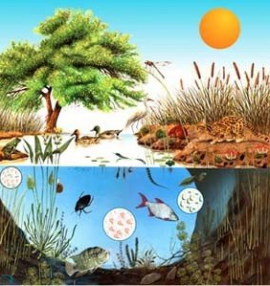Activity 3
Comparing ecosystems
Remember that anecosystem, aquatic or terrestrial, is the group of biotic and abiotic
factors and their interrelationships . So… how are aquatic and terrestrial ecosystems different?
In this activity we will look at their similarities and differences.
An infinity of ecosystems are possible because of the variety of different environments on the planet.
However there are two main groups: air-terrestrial ecosystems and aquatic ecosystems. The characteristics of each one depend
on the environment where life develops: air, water or earth.
Water cools and heats up slower than air so temperatures in aquatic environments are more constant
than on land. Extreme temperatures can be found near volcanoes or the Poles on land. Even in the same ecosystem, like the
desert, temperatures can change from hot to cold in the same day.
Another important difference is light, which is mainly constant in terrestrial environments but
diminishes rapidly under water. In the case of marine environments, an important abiotic factor is salinity.
Can all living organisms inhabit all types of environments? Do living organisms establish the same relationships
in one type of ecosystem as another?
Activity
In groups, compare the tables of biotic and abiotic factors you made to describe a terrestrial ecosystem and an aquatic ecosystem.
Consider :
- Are there different elements in each list?
- Which environment do the organisms live in, water, earth or both?
- Is the temperature stable or variable in each case?
- What is the intensity of light?
- Can living organisms from terrestrial ecosystems inhabit aquatic ecosystems? And can living organisms from aquatic ecosystems
inhabit terrestrial ecosystems?
- Are the relationships different between living organisms in one or another ecosystem? Are there any similarities?
With the answers to these questions, make a list of the similarities and differences on the digital board. For example:
SIMILARITIES
| DIFFERENCES
|
|
In both types of ecosystems there are biotic and abiotic factors.
| The availability of water is different.
|
Go back and read the definitions of an ecosystem. Do you think that in both cases it complies with the mentioned elements?
Now that you know more about the terrestrial and aquatic ecosystems, do the next exercise to help you to compare them:
Access this exercise and mark the statements true or false.
In the next exercise you will see a series of biotic and abiotic factors. Select which ones belong to a terrestrial ecosystem,
which ones belong to an aquatic ecosystem and which ones belong to both ecosystems.
At the end of this activity you can see that:
Both terrestrial ecosystems and aquatic ecosystems contain biotic and abiotic
factors but the characteristics of the environment and the relationships can be different, making very different ecosystems.














